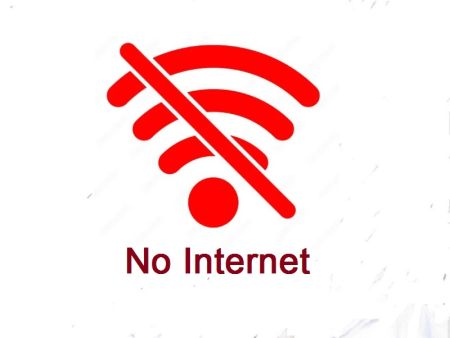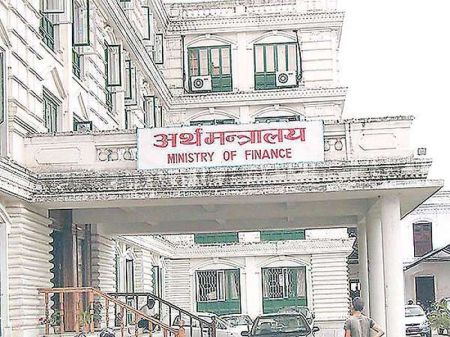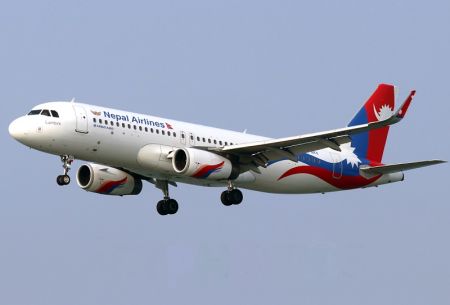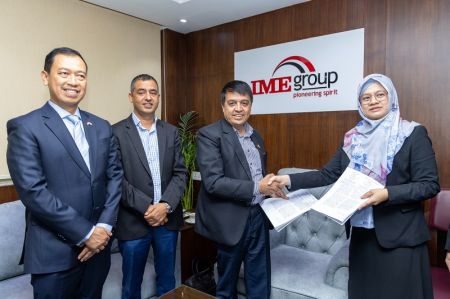By Prof Ujjwal K Chowdhury
.jpg)
Media convergence is a theory, and subsequently a practice, in communications where every mass or niche medium eventually merges with each other to the point that they are indistinguishable from each other, creating a new medium from the synthesis, due to the advent of new communication technologies. With the advent of new medium over the Internet and the mobile, media convergence is now an increasing reality in the Nepali media and entertainment industry.
A prominent example of media convergence in Nepal is the online media. It has had a significant impact upon the conventional print and broadcasting media. Globally, it has proved to be very influential. In the USA and other developed nations of the world, everyone uses advanced technologies such as iPhone, Blackberrys and other gadgets that help them stay updated every second. People do not wait for the next day to read the newspapers. The online news portals get updated every minute with new news flowing in. According to Suresh Prasad Aacharya, Academic Advisor at the Shepherd College of Media Technology, such an example can also be seen in Nepali radios. Radios provide news bulletins every hour. The same news is followed by the televisions and is viewed by the audience in the evening.
The online portals also update the news. Next morning, almost the same news is printed in the newspapers. Again, the radios conduct programmes in they which repeat the same news they broadcast a day ago. Hence, a cycle of convergence can also be seen in Nepal as the news reports get reproduced again and again by various forms of media. This is beneficial to the media consumers as they can stay updated through various forms of media. But this process weakens the media houses. Reporters can also benefit from this cycle. Most of the print media located outside the valley use online sources for the news.
Challenges in Convergence
While the industry at large is excited about media convergence, it also has its share of concerns. The unanimous one is the lack of adequate bandwidth. The bandwidth cost is too high and needs to be brought down drastically. In Nepal, Internet usage is very low. The fact that 18 per cent of the population uses the Internet is exaggerated. Hence, this makes it difficult for the media companies to use the Internet to communicate with their audience. Only 5-6 per cent Nepalis have been able to make effective use of the Internet. In Korea, there are half-a-million subscribers who receive 11 channels live on their mobiles. Only when there is enough bandwidth, can the business be ramped up.
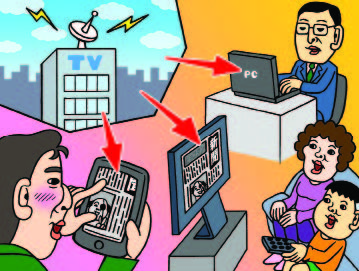
The other challenge is educating consumers to use the various new media. The latest technologies such as HD camera and the latest software are not being utilized to the full extent. Though we capture advertisements in HD (High Definition), it is shown in SD (Standard Definition). This has been making a little difference in quality but the full potential of technology remains unexplored. Consumers here have some access to the latest technological goods but consumer education for their proper usage is not being encouraged. The industry will not grow unless the consumer is educated and aware of the available technologies and their usage.
Apart from reaching consumers at various touch-points through convergence of the media, companies are also looking at it as a media to cater to the individual needs of consumers. And for this, the need of the hour is to generate adequate content. The Nepali media lacks the competition to generate adequate content. Producers are not compelled to make better advertisements. Advertisements are reflections of the competition among the brands. The clients want only glossy ads. They have a conservative mentality, as they want to stay 125 per cent secure. They prefer traditional, tried and tested methods that are still selling. Bringing creativity in media and advertisements requires more courage and clients by nature want security. Content availability has not kept pace with the changing consumers. Content generators have to generate enough to cater to individual tastes.
Another perspective to the challenges is the industry - one where companies need to be more and more competitive in their marketing and product strategies. For this, they need to constantly innovate new products and therefore, reallocate an increasing amount of resources to research and development. Looking at the TV commercials in Nepal, one can easily see the lack of competition to generate adequate content Most of the commercials are that of FMGC (Fast Moving Consumer Goods). These markets are somewhat competitive and thus they focus on generating enough content to attract their consumers. However, for the products with uncompetitive market, the need to make the extra effort is not felt. This can result in the lack of contents in media. As more companies compete, the gestation period for newer products also decreases with each product life cycle. Companies should not only concentrate on selling units but also on creating a brand image.
Finally, the lack of multi-skilled professionals in the newer arenas of business makes it difficult for the company’s old guard to let go of draconian or obsolete practices. This ultimately leads to turf wars over domain control. Convergence along with technological advancements has brought a tough competition in the media market. However, the level of seriousness is still very low. Acharya shares, “There is stiff competition to be the first to give the news to the audience but the accuracy and credibility of the news is lacking.” The skill demanded by Media Convergence is not being provided. He further says, “A computer literate media person is not good enough. We are using computers as typewriters and to get access to news only. Modern forms of technology should be better utilized. More creativity can be presented by using them which is not being done”. Nepali media is not fully aware about media creativeness. “Media are aware but not serious because they use online media for their convenience right now but they are not making long term assessments,” he says. In a period of 10 years, only the fittest will survive. His only request to media editors and directors is that they should stay updated with latest trends in media through training or orientations.
Market and Technology Convergence
By plotting time against portability and interactivity and at the same time, selected parameters that might be called the benchmarks of technology progress namely moving image, computing, voice communication and games, we can get a historical perspective as well as deduce where the combined technologies are headed.
However, in this case of mapping, the word convergence is never intended to suggest replacement (i.e. not everything is moving to one entity or point). All of the elements on the charts are still in existence and, except for VHS and DVD, will be around for a good while. We also see ‘divergence’ of media forms as it morphs across a sea of devices that continue to grow, layer upon layer.
All technology makers and marketers would like to know what the next will be. In the portable domain will we always have separate phone and serious gaming device? We are already seeing the merging of the phone, organiser and media player (4GB phones are already in the market) – given you can dock these portable devices to the larger screen, carry all your content and that they can receive high definition TV, do we need fixed devices at all?
Technology Convergence in Nepal
iPhone can be used in Nepal but it cannot be fully utilized. The phone clearly denies the user an access to its online stores by saying that the service is not supported in the region. This is due to the lack of an online payment system. On the contrary, Nokia phones are developing local contents for Nepal. Microsoft also provides Nepali language fonts for usage. However, the customers can use only the free services and not the priced contents. This can result in slow usage of technologies also. The telecom companies should be involved in this business. Both Ncell and NTC are providing mobile Internet service. This helps the users to use more social entertainment sites and random online contents but making full use of the latest technological innovations is difficult. Ncell has come out as the market leader with its gorgeous advertisements and user-friendly services. However, the customers want more.
Convergence of Understanding, Practicing and Innovating
Increasingly, one can observe a definitive trend in the convergence of understanding, practicing and innovating in the competitive marketplace where each participant is eying the largest chunk of the pie. Understanding the needs of the consumer has taken on a new importance with extreme segmentation and fragmentation in the marketplace. Identifying this need and creating a new product or service to fill this gap has gained prime importance, more so akin to a rasion d’être for the companies. From high value-high involvement products like home loans and automobiles to low value-low involvement products like detergent powders and toothpastes to soft drinks, companies are increasingly spending huge amounts of money to understand the patterns and motivations of the consumers for selecting, purchasing and using a certain brand.

Even more important, the brand association that the consumers make with a certain brand can make or break the brand equity of a company’s product and the difference between success and failure of the product in the market. A constant drive to innovate and come out with better products is reflected in the ever-increasing amounts of R&D spending of the companies. For example, high technology products like Nokia’s mobile handsets are made based on a constant feedback on usage and understanding of mobile phones by the customers. This has led to the incorporation of higher levels of innovation and user-friendliness in the next handset made by Nokia.
A new concept on the horizon is co-creating value. This happens between the consumer and the manufacturer. The manufacturer actively seeks the cooperation of the consumer for creating new products.
Convergence of Creativity/Design with Technology and Business Sense
It wasn’t a long time ago when even the top copysmiths of advertising like Neil French used to write copy for ads and fit them in typesets for printing. Nowadays, even a copywriter in a small agency in a small town will type out the copy quickly on the computer and the graphic designer will fit it into the ad’s layout and send out the soft copy to the newspaper for printing. Technology innovation from typewriters to computers has made this shift possible. A school student with a typical Pentium desktop computer has, at his disposal, more computing power than NASA had when it sent the first man to the moon. The great enabler in this case, technology, is progressing with such rapid pace that the latest, most cutting-edge technology is rendered almost outdated within a few months of its release. Creative visualisers using advanced software like Adobe Photoshop and CorelDraw are daily creating breathtaking graphical masterpieces that would have taken even a Leonardo da Vinci months, if not years, to create.
Convergence in technological standards like image formats (jpegs, gifs, etc.), audio-video formats (mpeg, avi, etc.), audio formats (mp3, wma, etc.), and so on, combined with interpolability and compatibility to use, share and transfer this data (USB, flash drives, DVDs and other optical storage) has created a powerful technology-design combo that professionals across the world are using in physical form as well as virtual form (cyberspace – Internet). Add to this, the keen entrepreneurial mind of a businessman and you have technology monoliths like the Times Group and others like AOL-Warner, Sony and Apple amongst many others who dominate the commercial landscape. Convergence is changing the way people live their lives on a daily basis. Convergence of Classroom (Brick & Mortar) with Internet (Click & Portal) and Learning by Doing (Experiential):
Experiential Brick and Portal

Traditional classroom model has been in an evolutionary phase ever since technology innovations have made networking possible. Satellite communications like VSAT have enabled hundreds of thousands of students across the world to virtually attend lectures. The University Grants Commission (UGC) has empowered students in India because of this education and technology convergence. In professional courses, the emphasis has always been on practical knowledge rather than just theoretical inputs. The value addition to the professional skills development is far more when students are exposed to theories and their practical applications. Added to this is the new dimension of Internet learning. Numerous universities, colleges and institutes, especially in Western Europe and North America, are now offering degree courses through the Internet. This dissolves all cultural, geographical and social barriers for people who cannot afford the time and/or money to attend full time courses in foreign countries. The effective combination of these three models of learning- traditional classrooms, Internet and practical experiences, has become necessary for the students of today to become successful professionals of tomorrow.
Nepal is moving towards using technology for education, replacing the traditional “Chalk and Talk” method. Midas Education, a pioneer in the development of ICT (Information Communication Technology) in the education sector, encourages interactive teaching and learning. Students make use of PowerPoint presentations and other IT tools to enhance their skills and be prepared for the modern world. To bring a drastic change in the education sector, growth of ICT is very important. Information flow is unavoidable today due to the Internet and students are using GOOGLE for their education along with textbooks. The next challenge for Midas Education is to take ICT to the villages but as anyone can imagine, it is not an easy task. Use of ICT increases accuracy and quality of education and saves valuable time. Thus, ICT is necessary to modify the existent education pattern and to develop it.
Initially, it is difficult to use a new technology and learning it might take some time. But, as soon as we get used to it, there are only benefits to enjoy. Technology makes life comfortable and fast. The real beneficiaries of technology in Nepal are the students. Technology has been making their lives easier. They can easily grasp vague concepts. They do not need to mug up their course books these days; they have a chance to present their creativity. Along with the students, teachers are also benefiting.
Convergence in Media Consumption & Media Buying
There was a time when you had simple choices to make – like choosing one newspaper from the three or four available, one radio station, one television station that broadcast only in the evenings, a couple of magazines from half a dozen available and so on. As the market kept segmenting and fragmenting, we now have thousands of radio stations to choose from with WorldSpace, Star TV itself telecasting more than half a dozen channels round the clock, there are more than a couple of dozen newspapers to choose from, hundreds of magazines to choose from and the story does not end there. With the advent of newer technologies, we now have newer channels of communications like mobile, Internet and direct-to-home television along with exponential storage capabilities on optical media like CDs and DVDs. Today, a typical consumer is bombarded with more than 1,000 messages per day. Marketers are finding newer ways and means to target the consumers.
One limitation for media consumption and media buying for Nepali consumers comes from the frequent load-shedding. This problem also makes an impact on the convergence cycle. The current trend is that the media houses are using all forms of media from print to radio to TV to online portals. One form of media is subsidizing the other. During the winter season, when the load-shedding is at its peak, advertisements in the TV decrease significantly to only 25 per cent as compared to the summer season. However, while the TVs are suffering from losses, the ads in the radio increase. Thus, radio subsidizes TV. Image Channel initially owned two TV stations: Image Channel and Image Metro. Now, it has replaced Image Metro with a new radio station, Image News, while the already existent Image FM still exists. This is an example of merging different types of media in one window, which is possible due to media convergence.
Another example of convergence in media consumption is the way in which consumers actively hunt for information. 3G mobile handsets are designed for high speed Internet connections and the user opts to use them in a variety of ways; like checking the online navigation to watch out for traffic jams, weather forecasts, locating the nearest fuel station, hospital or even a restaurant; everything is possible with the mobile handset. It also backs up as a personal information manager (PIM), a music player, a camera and a portable gaming device. Internet usage on the phone is aiding to media consumption but many people cannot afford it.
Convergence in Media Ownership
A massive diversification of media, thanks to the Internet, materialized by millions of websites, fora, blogs and wikis is taking place. That evolution, often labelled citizen journalism or citizen media, makes it possible for practically everybody to be a media creator, owner and actor, instead of a passive user.
With the technological advancements, convergence is expected to take various new forms. One form of media subsidizes the other and this poses a risk of developing a media tycoon. Currently, the Kantipur Media Group can give a run to the state media monopoly. It has an online news portal, a TV channel and radio broadcasting stations along with print media of daily and weekly newspapers, and monthly magazines. It is also considered the fastest and most reliable source of news. This has all been possible due to the proper utilization of technology.
Some of the largest media conglomerates in the world include American Media Inc., Bell Globemedia, Bertelsmann, Canwest Global, NBC Universal, Hearst Corporation, Lagardère Media, Liberty Media, News Corporation, Grupo PRISA, Rogers Communications, Sony, Time Warner, The Times Group (distinct from Times Newspapers of News Corportation), Viacom (owned by National Amusements), CBS Corp (also owned by National Amusements), and The Walt Disney Company.
Convergence in the Interests of Dual Markets
As more and more companies across industries look at multiple media platforms, especially the digital media, it is also emerging as a revenue-earning model for most of them. Also, e-commerce is growing rapidly and a host of companies are setting up online shops across portals.
Two sides of Media Convergence
With freedom, come the responsibilities. Media convergence has made a positive impact upon the advertisers. They only need to buy a small space in the websites and their ads get displayed 24 hours a day for as long as they want. The ads on the TV and newspapers last for a shorter period and are comparatively more expensive than the online ads. The design of the advertisements can also be changed from time to time. Also, the growing trend of media houses trying to use all forms of broadcasting media and print media makes it possible for the advertisers to negotiate rates. Their marketing is now more cost effective than before. They can easily use different tools of media and show their advertisements to their consumers through websites, TV, radio, as well as newspapers.
.jpg)
The Interim Constitution provides publication and broadcasting freedom to media but again imposes certain restrictions that allow the media to enjoy only the relative freedom. The online media however does not follow these rules and regulations. Online media has no monitoring system and in today’s world, the flow of information is difficult to stop. Hence, news that can be harmful should be stopped from spreading.
The definition of media is not the same as it was a decade ago. Facebook is an example of this. This new social media has influenced us largely. Now, every citizen is a reporter as he or she can constantly update news through Facebook. The news about Paras Shah getting a heart attack was published in the Facebook before any other media houses could print or broadcast it. Technology is responsible for this. While 10 years ago, technology turned the world into a global village, today it has changed the world into a global family. If a person in Nepal gets married today and updates his photos on Facebook, his friend in the US can see the photos. This ignores the geographical boundaries and aids in sharing cultures between people of different nations. Thus, it has been making a positive impact worldwide.
When the Royal Palace Massacre took place in 2001, a rumour was spread saying that somebody had mixed a poison in the water coming from the Water Supply Tank in Sundarijal. That was a time when people had no other forms of communication except for the landline phones at their homes. If that was enough to discourage many people from drinking water inside Kathmandu valley, we must think how effective can such rumours be today. We have all the powerful tools of communication from mobile phones to the Internet and it will take only seconds for such rumours to spread. Hence, with media convergence, self-regulation is required. People are required to be more responsible. Ill-intended propaganda and rumours should not be published.
Future Impacts
It is certain that over the next five years, technology will not remain the same. Newer versions will be available that will bring about more revolutionary changes. Hence, impact is a vague word in future terms. With changes in technology, the working processes will change which will provide the necessary opportunities towards beneficial transformations. The use of the latest technology produces beneficial products but education regarding technology is a limiting factor for a country like ours. With around 50 per cent of the graduating population having some form of knowledge regarding Information Technology (IT), it is not an impossible challenge. However, the business owners and leaders have the responsibility of encouraging this population for increased use of IT.
Media Education: Need for a Paradigm Shift
The world today is in the midst of one of the most dramatic technological revolutions in history. It is effecting changes in everything ranging from the ways we work, communicate commerce and spend our leisure time. The technological revolution which is underway centers on computer, information, communication, and multimedia technologies and may be seen to be the beginnings of a knowledge or information society. In such a society, education has a central role in every aspect of life. The proliferation of communication-information technologies poses tremendous challenges. It compels educators to rethink their basic tenets and to deploy the media in creative and productive ways. It forces them to restructure ways of learning-teaching to respond constructively and progressively to the technological and social changes that we are now experiencing.

Midas Education has been contributing to the development of ICT for education for about 12 years now. This continuous growth of Midas comes from continuous positive responses and moral support they got from their customers. Just like the processors developed in recent years from Pentium IV to i7, adding more layers in their newer versions, Midas has also been adding layers in their work to promote the use of ICT in the education sector. Raju Baniya, Business Manager of Midas Education, says, “This has improved our results year on year. We started with making self learning CDs and now we are trying to transform the class rooms.
As a consequence of information super highway and communication technologies, media and communication education have undergone almost unbelievable changes. The old lines between disciplines are becoming obsolete. The work of professional communicators is undergoing a dramatic change. Resultantly, there are likely to be very few belonging to one discipline which might be conversant with all forms of media in the days to come. With such metamorphosis of the professions underway, it is a real challenge to prepare students for successful professional careers in the era of convergence and connectivity of the variety of media.
In an era characterized by convergence of technologies the need for skilled media professionals who understand the foundation, both ethical and practical, from which they need to work, becomes even more critical. But without adequate training in new media skills, the goal will remain unachievable. This crisis in media requires to be addressed in the class room where young professionals are molded and sculpted. But to meet the needs of the fast growing media industry, an ongoing training is vital to ensure that those working in the field have to grow and develop. This entails broadening, updating and upgrading the core component of the media education at various levels.
.jpg)
What media students today need is nothing short of a leading-edge education suited to the needs of networked globalised industry. This would involve greater accent on fundamental concepts, values and skills needed to prepare them for communication careers commensurate with unprecedented changes. They need be fully equipped to understand the whole of communication scenario, be able to solve problems and imbibe the ethical and legal implication of media and communication which will let them be comfortable with innovation and working in concert with their peers. The object of the new media education is to prepare students for leadership roles in their professions and in their communities.
With a view to achieving the object of quality media education, the institute of Mass Communications are in dire need of reconfiguring and updating their curriculum to produce graduates who are prepared for future leadership roles in the media and communication industries and who are able to communicate across disciplines and in multiple media formats. This for providing students with strong core content in critical thinking, research and analysis, information gathering, writing, graphics and design, and law and ethics and the latest media technology and skills. It is not always possible for teachers to take students to lab to conduct required educational activities. Similarly, the task of taking students for field visit for practical knowledge is also not possible every time. In this context, the MiDas eCLASS offers audio-visual contents that complement the lab activities and field visit to enable the students to gain real-life experience.
The media education departments must offer to their students fully computerized reporting and editing classes, and create totally digital classroom and laboratory systems. They must orient themselves to revise their journalism curriculum and always be ready to undergo continual adjustments in response to changes in the profession. Far from print and broadcast sequences running separate, as is the case today, students in the two sequences need to plan news coverage together and work together in the labs. Tomorrow, it is quite likely that the sequences might disappear and students will be required to work seamlessly on stories for print, electronic media and the Internet – or whatever systems will exist in the future.
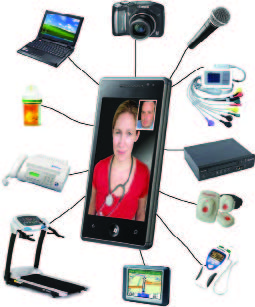 Same is the case for students of marketing communications who need to integrate the different tools of branding and marketing: advertising, public relations, event management, digital marketing, direct marketing, etc, before specializing in one functional area.
Same is the case for students of marketing communications who need to integrate the different tools of branding and marketing: advertising, public relations, event management, digital marketing, direct marketing, etc, before specializing in one functional area. For entertainment media students, it is significant to integrate skills for the entire entertainment industry: from television to cinema, from radio to digital entertainment, from events to musicals, etc.
We are entering in an era of Jack of all trades, yet Master of ONE.
E-marketing
Email marketing is a form of direct marketing, which uses electronic email as a means of communication marketing messages to an audience. Sending emails to existing customers helps businesses enhance its relationships with its customers, build brand royalty and prompt repeat businesses. When Electronic Direct Mailers (EDMs) are sent to another base, it can help to acquire new customers and build top-of-mind brand recall. Every email sent to potential or existing customers is considered email marketing, serving mainly the following objectives:
Cost-effective
Email marketing, such as Electronic Direct Mailers (EDMs), is one of the most cost-effective digital or online marketing options. Hence, email marketing is commonly adapted by businesses.
.jpg)
Fast & Flexible
Delivery time can be as short as seconds or minutes, as compared to snail mails which may take up to days depending on the geographic location. The email can also be customized accordingly and sent with plain tech, graphics or attached files.
Extensive Reach
Compared to other media investments such as direct mails or newsletters, email marketing has the ability to distribute information to a wide range of specific, potential customers.
Performance Tracking
The performance of an email blast can be easily tracked via read receipts, bounced messages, auto-responders, unsubscribe requests and click-troughs. These mechanisms will depict the reach of the email marketing messages (via open rate), its consequences (negative or positive) and correlate to sales generated.
Allows Forwarding & Feedback/Interactions
Email messages can be forwarded to the next person easily, hence broadening the reach of the marketing messages. By providing convenient links in the email, email recipients can “interact” with you by requesting for future emails or other messages to be delivered automatically. They can also sign up for memberships, update profiles and interests, or register for events.
- Prof Chowdhury is former Dean, Symbiosis International University, Pune and President, Adisory Board, Whistling Woods School of Communication, Mumbai









